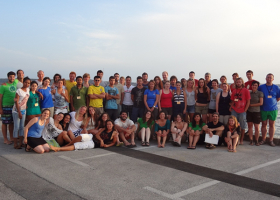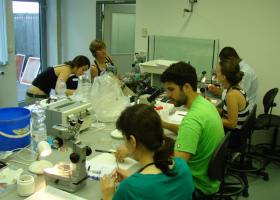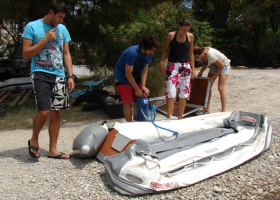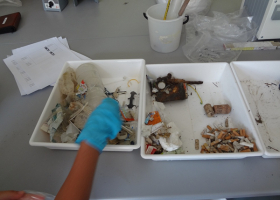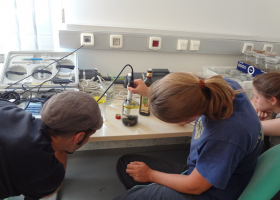16
Jul
43 students from all over the world on summer school at the Marine Biology Station
The Erasmus Mundus Master of Science in Marine Biodiversity and Conservation (EMBC) is a two-year Master programme offered by a University consortium consisting of 6 partners: Ghent University (Belgium), University of Bremen (Germany), University of the Algarve (Portugal), University Pierre et Marie Curie - Paris 006 (France), University of Oviedo (Spain) and University of Klaipèda (Lithuania). Between the first and second Master year all students join together on a summer school from 10 to 21 July 2012 in Slovenia. All 43 students and seven teachers are hosted at the Marine Biology Station of Piran (MBS) for a varied scientific programme.
Dr. Mateja Grego of the institute acts as local organiser and is responsible to ensure that all scientific challenges can be achieved in the best possible conditions.
Students are divided in small research groups of 3 to 5 people and work on ten topics all related to Slovenian marine Biodiversity and Conservation, which were proposed by the Slovenian researchers: the Strunjan lagoon is explored and mapped using a variety of exploration techniques, the effect of dredging in the harbour of Koper on sandy beaches nearby is researched, the litter on 6 slovenian beaches are analyzed together with microplastic pollution of beach and sediment, the spawning and egg production of fish in the Slovenian coastal waters is investigated, the effect of fish and shellfish farm in the Bay of Piran on the sea floor is studied, ...
Apart from the MBS staff also employees from the Institute of Fisheries, the Institute for Water of the Republic of Slovenia, the Nature park Strunjan, the fish farm Fonda and the Port of Koper cooperate with the students for the specific research.
The overall aim of this summer school is that students learn to develop scientific research from a very practical point of view in a short period of time. On top of that students are challenged to translate their research results to the public at large by means of short video documentaries.
It can be stated that this summer school helps the MBSS to become a well recognized partner in the field of International Education. The 43 students originating from over 20 countries all over the world will for sure remember Slovenia as a fantastic spot to enhance their skills in Marine Biodiversity and Conservation studies. Results of their research will be available through the Marine Biology Station of Piran.
More information about the EMBC programme is available at http://embc.marbef.org.
PDF
This email address is being protected from spambots. You need JavaScript enabled to view it. and This email address is being protected from spambots. You need JavaScript enabled to view it.
The research topics are:
Dr. Mateja Grego of the institute acts as local organiser and is responsible to ensure that all scientific challenges can be achieved in the best possible conditions.
Students are divided in small research groups of 3 to 5 people and work on ten topics all related to Slovenian marine Biodiversity and Conservation, which were proposed by the Slovenian researchers: the Strunjan lagoon is explored and mapped using a variety of exploration techniques, the effect of dredging in the harbour of Koper on sandy beaches nearby is researched, the litter on 6 slovenian beaches are analyzed together with microplastic pollution of beach and sediment, the spawning and egg production of fish in the Slovenian coastal waters is investigated, the effect of fish and shellfish farm in the Bay of Piran on the sea floor is studied, ...
Apart from the MBS staff also employees from the Institute of Fisheries, the Institute for Water of the Republic of Slovenia, the Nature park Strunjan, the fish farm Fonda and the Port of Koper cooperate with the students for the specific research.
The overall aim of this summer school is that students learn to develop scientific research from a very practical point of view in a short period of time. On top of that students are challenged to translate their research results to the public at large by means of short video documentaries.
It can be stated that this summer school helps the MBSS to become a well recognized partner in the field of International Education. The 43 students originating from over 20 countries all over the world will for sure remember Slovenia as a fantastic spot to enhance their skills in Marine Biodiversity and Conservation studies. Results of their research will be available through the Marine Biology Station of Piran.
More information about the EMBC programme is available at http://embc.marbef.org.
This email address is being protected from spambots. You need JavaScript enabled to view it. and This email address is being protected from spambots. You need JavaScript enabled to view it.
The research topics are:
- Effects of sediment deposition on benthic communities near the port of Koper, Slovenia
- Impacts of finfish and shallfish mariculture on the meiofauna community in the bay of Piran
- Assessing marine litter and microplastics along the coast of Slovenia
- Ecological differences of seagrass Cymodocea nodosa (Ascherson, 1869) inside and outside marinas at the Slovenian coast
- Comparison of invasive and non- invasive sampling methods of macrobenthos
- Bio-accumulation of the polycyclic aromatic hydrocarbons in mussels and sediments in the Gulf of Trieste.
- Evaluation of genetic diversity of communities along a salinity gradient in the Slovenian coast
- Effects of biotic and abiotic variables of Stjuza lagoon and Koper mudflat on avifauna in Slovenia.
- Estimation of spawning stock biomass of anchovy (Engraulis encrasicolus) and diatribution of fish eggs and larvae.
- Habitat mapping of Stjuza lagoon - ecosystem mapping (biotic and abiotic factors) of the lagoon and comparison of biotic factors (seagrass) to nearby coastal waters







